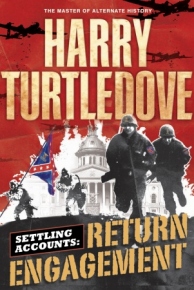

SETTLING ACCOUNTS: RETURN ENGAGEMENTby Harry TurtledoveDel Rey0-345-45723-4623pp/$26.95/August 2004 |
 |
Reviewed by Steven H Silver
At the end of the novel American Empire: The Victorious Opposition, Harry Turtledove had Jake Featherston, the President of the Confederate States of America, order a surprise air attack on the United States, setting the stage for another round of the incessant warfare between the two countries which dated back to the War of Secession, the Mexican War (chronicled in How Few Remain), and the Great War (chronicled in the Great War Trilogy). Once again, Turtledove turns his attention to the battlefield in Return Engagement, the first book of the Settling Accounts Trilogy which will provide a World War II analog to Turtledove s alternative world.
In many ways, the book is exactly what readers of the series would expect. Switching between numerous points of view, Turtledove focuses his attention on different aspects of the war, although he also spends quite a bit of time away from the front lines. Because of the breadth of his characters and the situations he has set up, he is able to show union activity in Los Angeles, the spread of modern conveniences in Sonora, and civilians in cities being bombarded as well as the front line action seen by Colonel Morrell and General Dowling as they work to stem the Confederate Blitzkrieg on its push to split the United States.
It is interesting that even as Turtledove shows that wars don t change anything and the same pieces of real estate are being fought over again and again, he has also set up a situation in which an aggressor (in this case the CSA under the Hitler-esque Jake Featherston) will only respond to violence. However, despite numerous similarities between Turtledove s scenario and some of his characters to World War II, the book is not simply a rehash of that way, bringing into play a variety of changes and personal points of view which highlight differences between World War II and the fictional campaign.
In his use of multiple viewpoint characters, Turtledove tries to show the forces driving their different agendas as well as different parts of the conflict and the war. In many cases he is successful, although occasionally he fails. Canadian terrorist Mary MacGregor Pomeroy comes across as particularly unsympathetic despite seeing her resistance through her own eyes. Chester Martin s response to a new recruitment drive in Los Angeles, where he has been working as a union organizer seems more a matter of plot than character. Other instances work much better. With his life in shatters behind him, Jonathan Moss s entry into the war is a logical response.
While many of the plotlines are well under way by the end of Return Engagement (and some are over as Turtledove once again demonstrates his willingness to kill off characters), other plot lines seem to be just beginnings. Cincinnatus Driver is hobbling around Covington again and appears to be getting sucked into the mechanizations of Lucullus and Luthor Bliss. A crackdown on the Terry is beginning to effect Scipio/Xerxes which seems to point to a ghetto uprising. In a variety of cases, the next generation of characters appears ready to take over from previous viewpoint characters, and at least one character who appears dead demonstrates a firm grip on life.
The biggest weakness inherent in Return Engagement is that it is a book without a beginning and without an end. While Turtledove reminds his readers of the characters backgrounds, the reader really needs to be familiar with the American Empire series before diving into Return Engagement, for the war really starts in the final pages of The Victorious Opposition. Similarly, Return Engagement ends with a cliff hanger that will only be resolved when the next volume in the series is published in 2005.
| Return to |